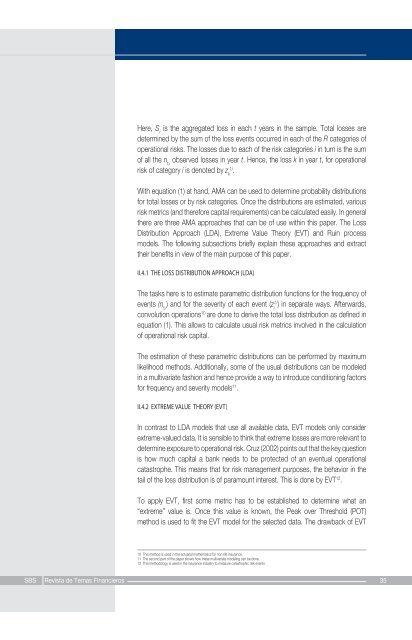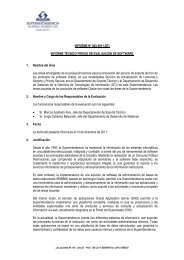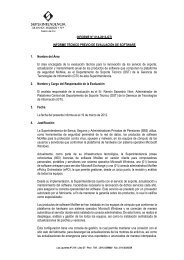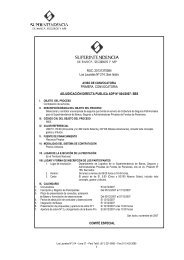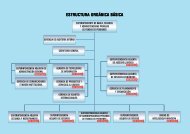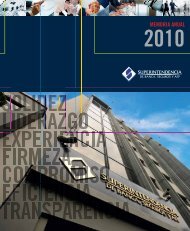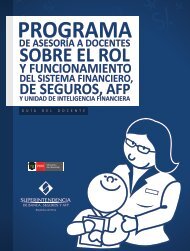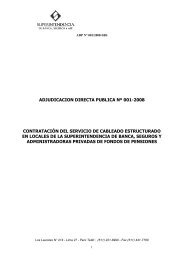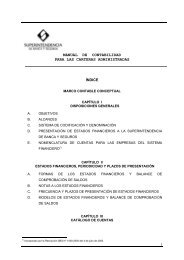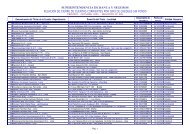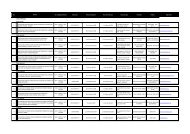Operational risk capital and insurance in emerging markets
Operational risk capital and insurance in emerging markets
Operational risk capital and insurance in emerging markets
Create successful ePaper yourself
Turn your PDF publications into a flip-book with our unique Google optimized e-Paper software.
Here, S tis the aggregated loss <strong>in</strong> each t years <strong>in</strong> the sample. Total losses aredeterm<strong>in</strong>ed by the sum of the loss events occurred <strong>in</strong> each of the R categories ofoperational <strong>risk</strong>s. The losses due to each of the <strong>risk</strong> categories i <strong>in</strong> turn is the sumof all the n t,iobserved losses <strong>in</strong> year t. Hence, the loss k <strong>in</strong> year t, for operational<strong>risk</strong> of category i is denoted by z kt,i.With equation (1) at h<strong>and</strong>, AMA can be used to determ<strong>in</strong>e probability distributionsfor total losses or by <strong>risk</strong> categories. Once the distributions are estimated, various<strong>risk</strong> metrics (<strong>and</strong> therefore <strong>capital</strong> requirements) can be calculated easily. In generalthere are three AMA approaches that can be of use with<strong>in</strong> this paper. The LossDistribution Approach (LDA), Extreme Value Theory (EVT) <strong>and</strong> Ru<strong>in</strong> processmodels. The follow<strong>in</strong>g subsections briefly expla<strong>in</strong> these approaches <strong>and</strong> extracttheir benefits <strong>in</strong> view of the ma<strong>in</strong> purpose of this paper.II.4.1 THE LOSS DISTRIBUTION APPROACH (LDA)The tasks here is to estimate parametric distribution functions for the frequency ofevents (n t,i) <strong>and</strong> for the severity of each event (z it,i) <strong>in</strong> separate ways. Afterwards,convolution operations 10 are done to derive the total loss distribution as def<strong>in</strong>ed <strong>in</strong>equation (1). This allows to calculate usual <strong>risk</strong> metrics <strong>in</strong>volved <strong>in</strong> the calculationof operational <strong>risk</strong> <strong>capital</strong>.The estimation of these parametric distributions can be performed by maximumlikelihood methods. Additionally, some of the usual distributions can be modeled<strong>in</strong> a multivariate fashion <strong>and</strong> hence provide a way to <strong>in</strong>troduce condition<strong>in</strong>g factorsfor frequency <strong>and</strong> severity models 11 .II.4.2 EXTREME VALUE THEORY (EVT)In contrast to LDA models that use all available data, EVT models only considerextreme-valued data. It is sensible to th<strong>in</strong>k that extreme losses are more relevant todeterm<strong>in</strong>e exposure to operational <strong>risk</strong>. Cruz (2002) po<strong>in</strong>ts out that the key questionis how much <strong>capital</strong> a bank needs to be protected of an eventual operationalcatastrophe. This means that for <strong>risk</strong> management purposes, the behavior <strong>in</strong> thetail of the loss distribution is of paramount <strong>in</strong>terest. This is done by EVT 12 .To apply EVT, first some metric has to be established to determ<strong>in</strong>e what an“extreme” value is. Once this value is known, the Peak over Threshold (POT)method is used to fit the EVT model for the selected data. The drawback of EVT10 This method is used <strong>in</strong> the actuarial mathematics for non-life <strong><strong>in</strong>surance</strong>.11 The second part of the paper shows how these multivariate model<strong>in</strong>g can be done.12 This methodology is used <strong>in</strong> the <strong><strong>in</strong>surance</strong> <strong>in</strong>dustry to measure catastrophic <strong>risk</strong> events.SBS Revista de Temas F<strong>in</strong>ancieros 35


